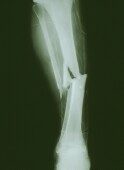
MONDAY, Jan. 17 (HealthDay News) — The U.S. Preventive Services Task Force has just expanded its osteoporosis screening recommendation to include younger women who have risk factors for the debilitating disease, which causes bones to become abnormally brittle and prone to fracture.
The newly released guidelines expand routine screening to include all women 65 and older as well as younger women at increased risk of bone fractures.
“This [new recommendation] extends it down to any postmenopausal-age woman whose risk is the same as a 65-year-old,” said Dr. Ned Calonge, chair of the U.S. Preventive Services Task Force (USPSTF).
One example, he said, might be a postmenopausal woman not yet 65 who weighs under 125 pounds, smokes, drinks and has parents with a history of bone fractures. All of those factors — thin frame, smoking, excess alcohol and family history — boost the risk of osteoporosis, he explained.
The new recommendations are published in the Jan. 18 issue of the Annals of Internal Medicine.
The USPSTF, which issues health-related recommendations after reviewing the available medical evidence, is sponsored by the federal Agency for Healthcare Research and Quality and composed of an independent panel of experts in preventive and primary care.
The guidelines suggest that doctors and policymakers look at the evidence underlying the task force recommendations, but also tailor their decisions to the specific patient or situation.
Noting that the new recommendations update the USPSTF’s 2002 guidelines, Calonge reported that in that year, “we had insufficient evidence to suggest women under age 60 would benefit.” More current research, however, “suggests that treating those women leads to reduced fractures,” he said.
Osteoporosis screening “is a test that patients should be asking about and clinicians should be providing,” he said. The most commonly used tests to screen for bone health are dual-energy x-ray absorptiometry (DXA) of the hip and lumbar spine and quantitative ultrasound of the heel, according to the USPSTF.
The task force also noted that therapies to prevent bone fractures from osteoporosis included adequate calcium intake, vitamin D intake, weight-bearing exercise and several approved drug treatments.
According to the new report by the panel, some 12 million Americans over age 50 are expected to have osteoporosis by 2012. Over half of all postmenopausal women will develop a fracture related to osteoporosis during their lifetime, including 15 percent who will suffer a hip fracture. Hip fractures, in particular, are linked with chronic pain, disability, loss of independence and an increased risk of death.
And these risks are not confined to women. Fewer men than women develop osteoporosis, but more than one-third of men who sustain a hip fracture die within a year.
Nonetheless, the USPSTF found insufficient evidence to recommend screening for men, Calonge said. “That alerts the research world [that] there is an important research gap,” he said.
The new recommendations are now closer to those issued by other groups, including the National Osteoporosis Foundation (NOF), said Dr. Robert R. Recker, president of the foundation. The NOF now recommends bone mineral density testing for women 65 and older, as well as some younger postmenopausal women, based on their risk factors, he said.
Unlike the task force, however, NOF also recommends testing for all men 70 and older, and for men aged 50 to 69 with risk factors, Calonge added.
The recommendations issued by the task force do get the ear of doctors in practice, Recker said. “A lot of primary care practitioners have a list of these various recommendations by USPSTF in their office and tend to refer to it.”
Studies have shown that managing osteoporosis pays off by reducing the fracture rate and overall costs, Recker said. One study, for instance, found that good management of osteoporosis cuts the hip fracture rate 25 to 50 percent.
More information
To calculate your fracture risk, visit the National Osteoporosis Foundation.

